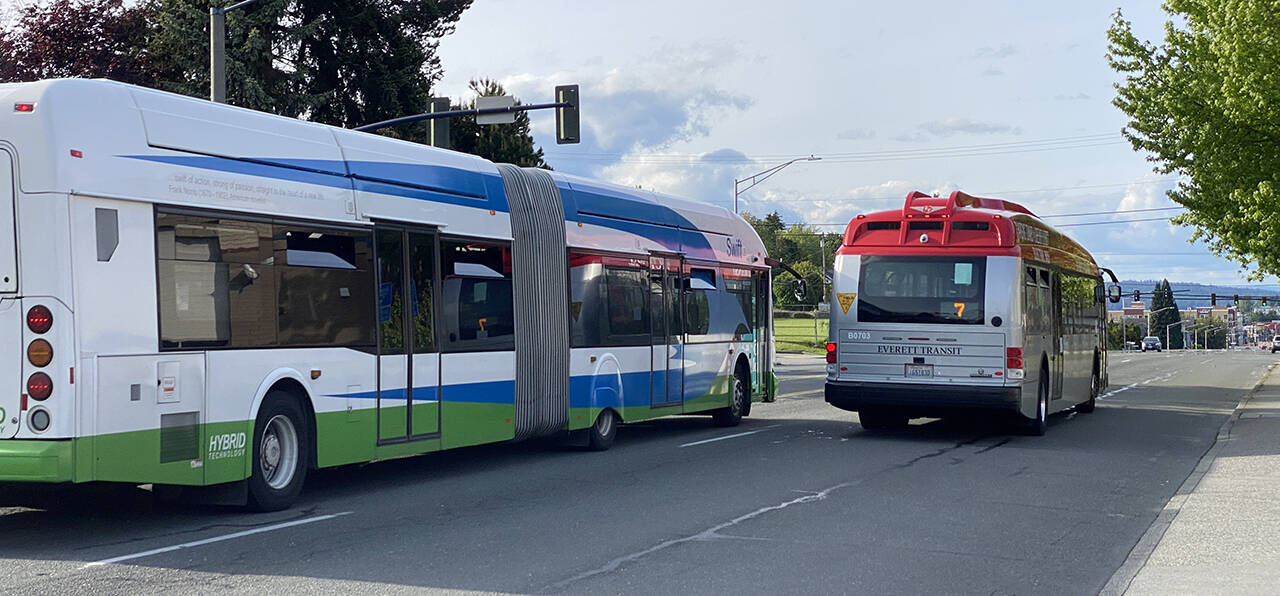By The Herald Editorial Board
For as long as the idea has been kicked around — whether the city of Everett should stick with its own city-centric transit service or consolidate with the countywide Community Transit — there hasn’t been enough information to decide which route would get either agency and the people they serve where they want to go.
“We are just talking in the dark,” said Everett City Council president Brenda Stonecipher, during last week’s council meeting. “We have no information to inform those assumptions” on what either option can provide and which would be the better deal.
Among the questions: What would be the fare costs for riders and for those paying the portion of the sales tax that goes to the two agencies? What would either option mean for route expansion and frequency? What neighborhoods will be served? How would the two bus systems combine their fleets and their drivers, mechanics and other employees? What would consolidation mean for continued growth of electric bus service in Everett and for neighborhoods served by Community Transit? How would consolidation change the makeup of the Community Transit board of directors to include Everett representation?
And what color would the buses be?
Wheels are now turning on an 18- to 24-month joint process, following unanimous votes last week by the city council and the Community Transit board, to get those answers, make a decision on what’s best for each agency and their communities and present Everett voters with the final decision on whether to combine agencies or keep them separate.
A big part of the calculus for Everett voters will be the cost, specifically an increase to the city’s sales tax rate. Currently, about 80 percent of Everett Transit operations are supported by a share of the sales tax collected by the city.
Of the current 9.8 percent sales tax in the city, 6.5 percent goes to the state and 3.3 percent to the city; of that, 0.6 percent — 6 cents on a $10 purchase — supports Everett Transit.
But the sales tax take for Community Transit, for which voters in its benefit district approved an increase in 2015, is currently 1.2 percent — 12 cents on a $10 purchase — added to the sales tax rates in the cities and communities it serves. Consolidation would require Everett voters to approve a 0.6 percent increase to bring its rate on par with the rest of the CT benefit district.
As part of the city’s effort to “rethink transit,” a report released earlier this year outlined three options for transit operations in the city:
Current funding: Making no change to the sales tax, this would allow a gradual return to pre-pandemic service levels of service with some limited addition to service but would not keep up with growing demand for routes to serve new jobs and residents.
Growth: Would keep Everett Transit as a city-managed agency and would go to the voters seeking an increase in the sales tax of .3 percent above the current .6 percent, for a total 9 cents on a $10 purchase. The new revenue over the coming decade would allow increased frequency of bus services, expanded hours on mornings, evenings and weekends and limited additional service as jobs and population increase.
Growth through consolidation: Combining the transit agencies would mean an increase to 1.2 percent for the city’s sales tax for a total sales tax of 10.4 percent. With Community Transit taking over local routes, the additional revenue, within about two years, would bring increased frequency and routes, increased access and reduced walk time to bus stops and expanded hours for mornings, evenings and weekends.
The joint review will assess that third option. The city, Mayor Cassie Franklin told the council, continues its own separate assessment on Everett Transit costs and operations regarding consideration of the first two options.
Leaving Everett Transit at its current funding level, however, isn’t an option that’s going to get riders or the city where they need to go.
In recent years, Everett Transit has often operated at a deficit, with expenses outpacing revenue. This has been occurring against the city’s own larger structural budget deficit as it has struggled to find the revenue to provide services for a growing community.
At current funding levels, the city’s transit system isn’t meeting current needs and can’t hope to meet those needs in the future; the city remains poised to see an increase of 60 percent in population with related growth in jobs and commerce over the next 20 years. At the same time, although still more than a decade away, transit service in Everett will have to prepare for the arrival of Sound Transit’s Link light rail service at several stations, including Paine Field and Everett Station.
“If we have any hope of achieving our growth targets without spoiling the quality of life in our community we simply must fund public transportation to a higher level,” Stonecipher said Wednesday evening. “There is a growing need to address transportation issues in our neighborhoods and in our community and part of that solution could be more public transportation so we can get more cars off the roads. We’re simply providing a level of service that does not entice anyone to take it unless they have no other option.”
As lengthy a process as “rethinking transit” in Everett already has been, the city, with the cooperation of Community Transit, now needs to make the most of the next 18 to 24 months to gather information and assess needs, costs and options.
Everett residents, whether they count themselves as transit users or not, need to be on board for those conversations.
Talk to us
> Give us your news tips.
> Send us a letter to the editor.
> More Herald contact information.

























